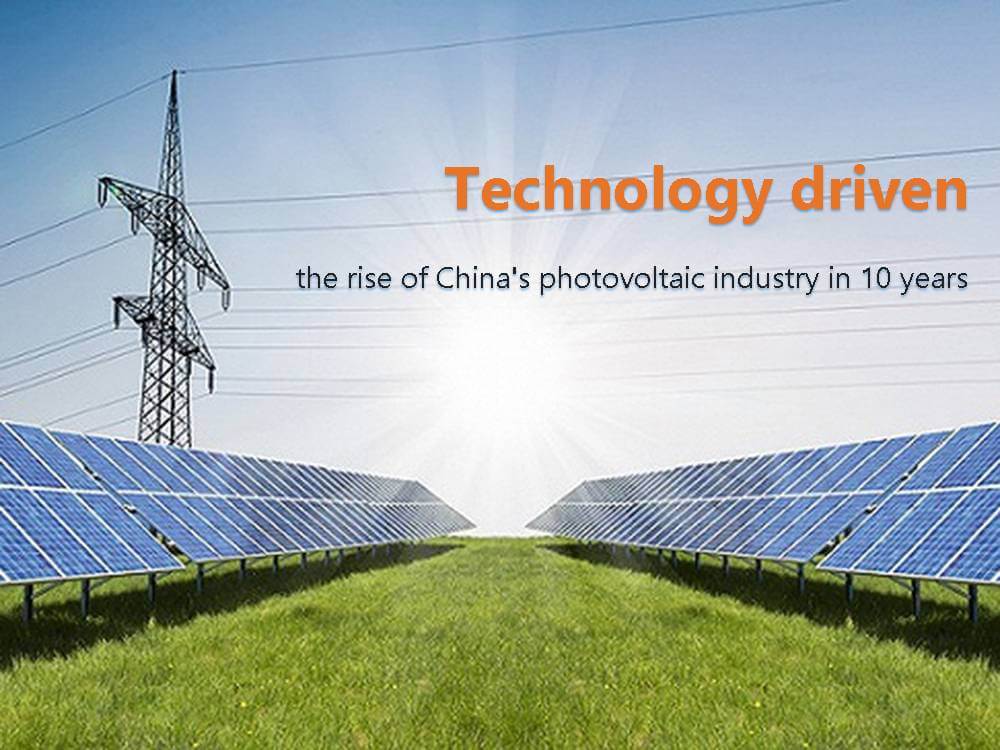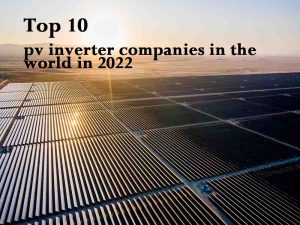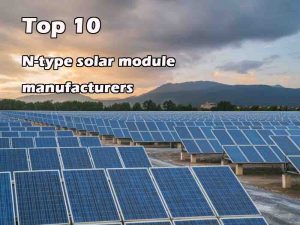Technology driven - the rise of China's photovoltaic industry in 10 years

From being controlled by others to firmly occupying the top spot in the world’s photovoltaic industry and becoming China’s business card in the new era, China’s photovoltaics only took less than 10 years. 10 years may not be too long for the development of an industry, but it means a lot of stories and experiences for the emerging industry of photovoltaics. Among them, technological innovation is an important force that cannot be ignored.
Ten years of tackling: from being controlled to leading the world
In 2012, for the newly emerging Chinese photovoltaic industry, at that time, the Chinese photovoltaic industry, whose raw materials, markets and core technologies were all controlled by others, ushered in the darkest moment, and the photovoltaic industry also fell to the bottom.
Professionals and experts have begun to realize that in order not to be blocked by others, core technologies, industrial chains, and supply chains must be firmly in their own hands. As a result, China’s photovoltaic industry has embarked on a tough road for ten years.
On the one hand, the Chinese government has introduced relevant industrial policies, from capital to market, from finance and taxation to land, quickly creating a favorable policy environment for the development of domestic industries.
In the following years, policies such as kWh subsidy, leader plan, household photovoltaics, green certificate trading and other policies have appeared successively, paving the way for the development and growth of the photovoltaic industry.
On the other hand, Chinese photovoltaic companies have also set off a wave of scientific and technological innovation. At that time, LONGi, JinKo and other companies continued to increase investment in technological innovation.
Among them, LONGi has been insisting on continuously increasing investment in scientific research and technological innovation. In just a few years, the entire PV industry chain has achieved rapid development.
Chinese companies live up to expectations, speak with strength, produce scientific research results one after another, and build a solid and stable supply chain step by step.
According to relevant data, by the end of 2015, in the four core links of photovoltaic manufacturing – polysilicon, silicon wafers, cells and modules, the output of domestic enterprises ranked first in the world, accounting for 48.5%, 79.6%, 62.6% and 76.1%.
At the same time, China has also mastered the 10,000-ton-level improved Siemens method polysilicon production technology, and the fluidized bed method polysilicon production technology has also begun industrial production.
The industrialization efficiency of polycrystalline vs monocrystalline cells reached 19.5% and 18.3% respectively, leading the world. In terms of special equipment for production lines, it has the ability to supply complete sets of equipment from silicon material production, silicon wafer processing, cell and module production to photovoltaic industry chain-related testing equipment and simulators, and some products have even achieved varying degrees of export.
Ten years of innovation: cost reduction and efficiency increase throughout
Throughout the entire process of photovoltaic cost reduction and efficiency improvement, there is a main line running through it, that is, technological innovation promotes the industry’s cost reduction and efficiency improvement.
In the past ten years, many links in the photovoltaic industry have set off route disputes, from crystalline silicon to thin film, from polycrystalline to monocrystalline, from centralized to string inverters, etc.
However, the fundamentals of these competitions lie in reducing costs and increasing efficiency, and improving the economy and competitiveness of photovoltaic energy.
Among them, the improvement of battery conversion efficiency plays a key role in the overall situation and has become the main track for the transformation and upgrading of the photovoltaic industry.
In 2015, this year, photovoltaic gradually got rid of the haze of the past. With the strong support of China’s policies, it finally ushered in a golden period of development.
Photovoltaic companies that have stepped out of the trough have begun to continuously promote technological upgrades based on market demand, focusing on performance and cost.
During this period, the market demand and technological development line were still dominated by polycrystal. Under the technological breakthroughs of JA Solar, JinKo and other first-line major factories, new technologies and processes such as light trapping and surface passivation, efficient polycrystalline ingot and wet black silicon emerged one after another.
Under the comprehensive support of these technologies and processes, the conversion efficiency of polycrystalline cells has broken through the theoretical limit of 20% previously recognized by the industry. But this is far from enough.
The market needs technologies and products with higher conversion efficiency, in order to achieve the goal of photovoltaic parity on the grid as soon as possible. At this time, the photovoltaic leader program came into being.
This top-level plan, which aims to promote the transformation of the photovoltaic industry from pursuing scale expansion to focusing on quality and efficiency, has become a testing ground for the upgrading of photovoltaic technology.
Driven by it, various advanced technologies began to compete for technological innovation and upgrading. Among the three batches of front-runner bases that have been launched successively since then, technologies such as PERC, PERC double-sided, heterojunction, and MWT have appeared one after another.
At the same time, the market has also given an answer to the choice of single and polycrystalline technology routes – the monocrystalline technology with extremely high cost performance stands out and gradually becomes the main force of the “leader” base and even the entire market application.
Before this, although the conversion efficiency of single crystal battery is higher and the development space is larger, but it is widely criticized because of the cost problem, and the photovoltaic owners and EPC enterprises do not know enough about the concept of KWH cost, so the cheap polycrystalline products occupy an absolutely dominant position in a period of time. Single turnaround also appeared during this period.
In 2014, LONGi took the lead in solving the industrialization problem of RCZ single crystal growth technology, and increased the silicon rod output from the original 60kg/ crucible to 1500kg+/ crucible.
With the application of this technology, the pulling speed is increased by more than 80%, the cost gap per kilogram of monocrystalline silicon rod and polycrystalline ingot is narrowed rapidly, and the huge cost gap between single crystal and polycrystal is narrowed rapidly, providing an opportunity for the rapid development of single crystal.
In 2020 alone, the technology saved China’s PV industry about 13.6 billion yuan in costs.
During the same period, another key technology related to the future of single crystal, diamond wire cutting technology, also took the lead in realizing the localization of China in LONGi.
It not only broke the monopoly of global manufacturers on diamond wire technology, but also quickly developed high-quality and low-cost diamond wire through close upstream and downstream joint technical research and technology introduction.
The supply price of diamond wire is quickly reduced to about 0.3 yuan/meter, which saves the industry 30 billion yuan in costs every year, and completely lays the foundation for single crystal to lead the industry pattern.
At the same time, the introduction of PERC cell technology has made the cost reduction advantage of single crystal technology more obvious.
JA Solar, JinKo in top 10 solar battery manufacturers and other battery module companies have turned to monocrystalline and PERC technology, which has made the value of monocrystalline modules further recognized by the market. During this period, LONGi, which has just entered the field of batteries and components, once again played a key role.
With the continuous efforts of many companies in the industry, new technologies and processes such as double-sided, half-cell, MBB, shingled, and multi-busbar are constantly emerging, making the monocrystalline efficiency curve continue to climb and the cost to drop again and again. By the end of 2017, the price of monocrystalline modules was almost the same.
So far, the advantages of single crystal no longer need to be proved through various parameter assumptions and complex calculations, which will have an intuitive and strong impact on the market, and complete the counterattack against polycrystalline in one fell swoop.
Ten years of transformation: from subsidies to parity
In the past decade, while pursuing technological progress, the photovoltaic industry is gradually getting rid of its dependence on policies and subsidies. It has not only achieved a historic leap from the era of subsidies to the era of parity, but also gradually transformed from auxiliary energy to main energy.
The intensity and speed of policy subsidy reduction far exceeded expectations, forming an unprecedented impact on the photovoltaic industry at that time.
Before this, benchmark electricity prices and gradually decreasing subsidy intensity effectively supported the scale development of the industry. But at the same time, higher on-grid electricity prices and power generation costs also restrict the further development of the photovoltaic industry.
In 2017, the average on-grid price of photovoltaics was still as high as 0.94 yuan/kWh, and the power generation cost was also 0.5-0.65 yuan/kWh. Compared with other forms of power generation, the price was not competitive. However, China’s photovoltaic industry has once again withstood the test.
In 2020, photovoltaics will usher in a new round of historic development opportunities. The successive proposals to achieve carbon peaking by 2030, achieve carbon neutrality by 2060, and build a new power system with new energy as the main body have endowed photovoltaics with greater historical responsibility.
Focusing on the implementation of the goals, China has introduced a number of new policies, which not only established the direction and strategic goals for the transformation of wind power and photovoltaics to the main energy status, but also completed the complete package from top to bottom once again, creating a favorable policy environment for the future development of China’s photovoltaic industry.
Photovoltaic thus entered a new historical development of a new period. In this stage, as one of the new subject, photovoltaic (pv) in order to realize technology continues to progress, not only costs continue to drop, continue to improve efficiency and competitiveness enhanced continuously, fully realize the subsidies, parity and even low marketization development, also want to speed up to solve the key technical innovation, high percentage given, industry chain supply chain security, stability, reliability and so on key issues.
For photovoltaic companies, innovation in photovoltaic power generation technology will remain a key factor in addressing these challenges. In short, throughout the past ten years of the development of China’s photovoltaic industry, technological innovation is the core driving force for the continuous progress of China’s photovoltaic industry.



























